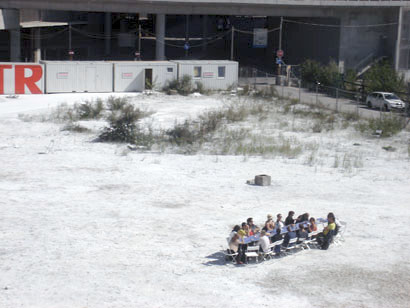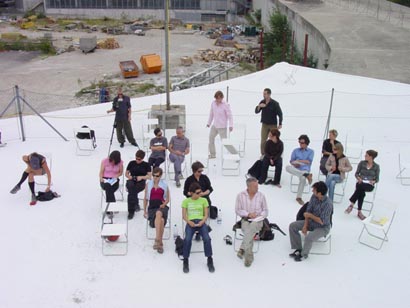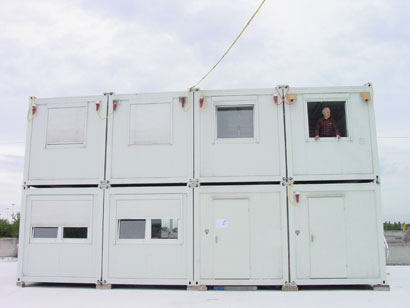| theatercombinat | 02.09. - 30.09.2005 palais donaustadt – installation. temporary art space at donaucity vienna with the formats ballet palais, firma raumforschung, archiv im palais, film im palais, picknick am wegesrand (a) language: deutsch, english |
|
concept / installation |
experimental installation for working, living and sleeping over a period of five days time. a laboratory, where scientists, artists and architects investigate spatial and temporal components of knowledge production next to the ongoing showings and rehearsals of theatercombinat and ballet palais. three container ensembles provide infrastructure and facilities, set-ups for sleeping and working. four groups consider the issues of palais donaustadt: contextualised spaces, temporary art and theatre spaces, performative areas of actions, monumentality and public space.
|
|
camp of firma raumforschung / space research inc. with sabine bitter, andrea börner, oliver frey, gabu heindl, irina kaldrack, christa kamleithner, rudolf kohoutek, bojana kunst, ralo mayer, bärbel müller, gini müller, georg schöllhammer, daniel schürer, peter stamer, christian teckert, bettina vismann, bernd vlay, helmut weber; concept: claudia bosse; collaboration: christina nägele, christine standfest, christian teckert camp: 5.09. - 10.09. 2005 10.09.: presentation 12h - 24h 17.09.: respondent camp and discussion with katherina zakravsky and members 24.09.: respondent camp and discussion with angelika fitz and members |
course |
the camp was opened with presentations of material and lectures by participants as starting points for the further collaboration. showers and WCs were provided for, collective meals on offer. changes of topics and combinations of groups were possible. for a final presentation, only material developed during this process should be introduced. the time frame was defined, modes and contents and spatial configurations should have been output of the process. each group was coordinated by a moderator to focus the different approaches. during the 12 hours of the final presentation, each group was responsible for three hours and chose the respective spatial setting for its presentation. the aim was to focus the horizons of thinking and activities of the whole 128 h for a selective audience in addition to the general observation given by the exposed publicity of the place, to exchange material and collaborate with the other groups. |
|
 |
working groups |
1) contextualised spaces palais donaustadt considers itself as visible intervention into a privatised space to claim it as public. |
www.theatercombinat.com theatrale produktion und rezeption

